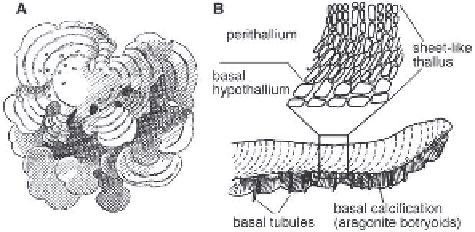Geology Reference
In-Depth Information
Nebelsick, J.H., Bassi, D. (2000): Diversity, growth forms
and taphonomy: key factors controlling the fabric of coralline
algae dominated shelf carbonates. - In: Insalaco, E., Skelton,
P.W., Palmer, T.J. (eds.): Carbonate platform systems:
compounds and interactions. - Geol. Soc. London, Spec.
Publ.,
178
, 89-107
Woelkerling, W.J. (1988): The coralline red algae: an analy-
sis of the genera and subfamilies of non-geniculate Coral-
linaceae. - 268 pp., British Museum Natural History, Lon-
don (Oxford Univ. Press)
Look at
http://www.botany.uwc.ac.za/clines/bibliog/Intro.htm
for the bibliography of Rhodophyta (prepared by W.J.
Woelkerling with over 4500 references), Coralline News, or
Rasser:
http://www.paleoweb.net/rasser/welcome-main.htm.
Fig. 10.8.
Peyssoneliacean red algae.
A
:
Peyssonelia
. The
thallus is built of thin blades.
B
: Internal structure of
Peys-
sonelia
composed of a thin hypothallium with basal arago-
nite calcification between downward projecting tubules, and
a thick perithallium. A: After Pia (1926). B: After Wray (1964).
Peyssoneliacean red algae
Definition, calcification and morphology:
Peysson-
eliaceans (formerly called squamariaceans) are a small
group of marine calcareous red algae, some of which
secrete an aragonitic skeleton. Calcification is both in-
tracellular and extracellular. The latter occurs as a layer
of small botryoids below the thallus projecting down-
wards from basal hypothallus cells. The botryoids are
similar to those forming aragonite cements (Sect.
7.4.2.1). The internal structure resembles some crus-
tose corallinaceans. It consists of rectangular hypo-
thallus cells (about 30
m high and 20
m wide) from
which vertical or arcuate rows of smaller perithallus
cells arise.
Distribution
: The confirmed fossil record starts in
the Early Cretaceous. Peyssoneliaceans are widely dis-
tributed in Cretaceous and Tertiary warm-water and
temperate shelf carbonates.
The algae are common in Paleocene and Eocene reef
limestones associated with corals, or limited to rhodoid
accumulations near reefs. Important genera are:
Ethelia
(also called
Polystrata), Peyssonelia
and
Pseudolitho-
thamnium.
Significance:
Striking similarities between calcified
peyssoneliacean algae and some Late Carboniferous
and Permian phylloid algae suggest that the latter may
be closely related, thus allowing a less speculative in-
terpretation of economically important phylloid algal
buildups (James et al. 1988).
The algae grow as arched millimeter- to centimeter-
sized sheets on soft mud substrates and hard rock sur-
faces, form a bridge-like network between corals in
reefs, and occur as concentric layers within nodules
(Fig. 9.7, Fig. 10.8). Growth forms are layered and fo-
liose. The former consist of superimposed layers with
little or no space between, similar to the growth of en-
crusting corallines. The latter is an open structure com-
posed of irregularly attached arcuate crusts forming
overlapping sheets with open cavities in-between.
In thin sections the crusts of fossil peyssoneliaceans
differ from corallinaceans by a transparent golden or
yellow-brownish tint in contrast to the uniform dark
appearance typical of coralline algae in general.
Basics:
Peyssoneliacean red algae
Buchbinder, B., Halley, R.B. (1983): Occurrence and preser-
vation of Eocene squamariacean and coralline rhodoliths:
Eua. Tonga. - In: Toomey. D.F., Nitecki. M.H. (eds.):
Paleoalgology, contemporary research and application. -
248-256, Berlin (Springer)
Denizot, M. (1968): Les algues Floridées envroutantes (à
l'exclusion des Corallinacées). - Thése, Laboratoire de
Cryptogamie, Museum Nationalè d'Histoire naturelle
Paris, 280 pp.
James, P., Wray, J.L., Ginsburg, R.N. (1988): Calcification
of encrusting aragonitic algae (Peyssoneliaceae): impli-
cations for the origin of late Palaeozoic reefs and cements.
- J. Sed. Petrol.,
58
, 291-303
Massieux, M., Denizot, M. (1964): Rapprochement de genre
Pseudolithothamnium
Pfender avec le genre actuel
Ethelia
Weber van Bosse (Algues Florideae, Squamariaceae). -
Revue de Micropaléontologie,
7
, 31-42
Moussavian, E. (1988): Die Peyssoneliaceen (auct.: Squam-
ariaceae; Rhodophyceae) der Kreide und des Paläogen der
Ostalpen. - Mitteilungen der Bayerischen Staatssamm-
lung für Paläontologie und historische Geologie,
28
, 89-
124
Environmental constraints:
Calcified peyssonel-
iacean algae occur in temperate, and tropical and sub-
tropical waters in depths between a few meters to more
than 100 meters. They are common down to 50 meters.
Distribution is controlled by light intensity, current re-
gime and sediment input. The algae are often associ-
ated with coralline red algae and encrusting foramin-
ifera.

